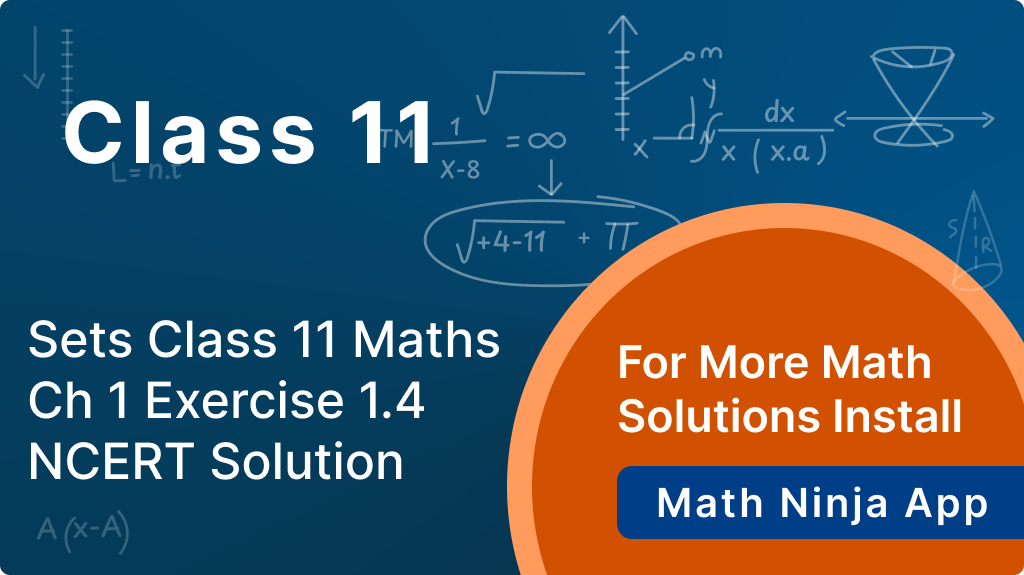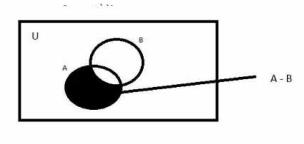class 11 maths ch 1 exercise 1.4 | exercise 1.4 class 11 maths | class 11 ch 1 exercise solutions | class 11 chapter 1 exercise solution | sets class 11 ncert solutions | ncert solution for class 11 maths chapter 1 | ncert exemplar class 11 maths
Looking for NCERT Class 11 Maths Exercise 1.4 solutions? You’re at the right destination! This section provides comprehensive and step-by-step solutions to all the questions in Exercise 1.4 of Chapter 1 – Sets. Designed as per the NCERT curriculum, these solutions cover important topics like complement of a set, practical problems on union and intersection, and more. Whether you’re preparing for an upcoming test or simply want to strengthen your understanding of sets, these Class 11 Chapter 1 Maths solutions are perfect for you. Download or go through the solutions now and gain confidence in tackling set theory problems!

ncert exemplar class 11 maths || exercise 1.4 class 11 maths || ncert solution for class 11 maths chapter 1 || class 11 ch 1 exercise solutions || class 11 chapter 1 exercise solution || class 11 maths ch 1 exercise 1.4 || sets class 11 ncert solutions
Exercise 1.4
1. Find the union of each of the following pairs of sets:
\(X=\{1,3,5\}\)
And, \( y=\{1,2,3\} \)
All the members of both sets together are \( 1,3,5,1,2,3 \). Now we don't have to replicate members. So, the members of union of these two sets are \( 1,2,3,5 \)
\( \therefore X U Y\{1,2,3,5\} \)
\( A=\{a, e, i, o, u\} \)
And, \( \mathrm{B}=\{\mathrm{a}, \mathrm{b}, \mathrm{c}\} \) All the members of both sets together are \( \mathrm{a}, \mathrm{e}, \mathrm{i}, \mathrm{o}, \mathrm{u} \), \( a, b, c \) Now we don't have to replicate members. So, the members of union of these two sets are \( \mathrm{a}, \mathrm{b}, \mathrm{c}, \mathrm{e}, \mathrm{i}, \mathrm{o}, \mathrm{u} \)
\( \therefore A U B\{\mathrm{a}, \mathrm{b}, \mathrm{c}, \mathrm{e}, \mathrm{I}, \mathrm{o}, \mathrm{u}\} \)
B = {x : x is a natural number less than 6}
\(A=\{3,6,9,12,15,18, \ldots \ldots\}\)
And, \( B=\{1,2,3,4,5 \)
\( \text{All the members of both sets together are }3,6,9,12,15,18, \ldots \ldots \ldots \ldots, 1 \), \( 2,3,4,5 \)
Now we don't have to replicate members. So, the members of union of these two sets are \( 1,2,3,4,5,6,9,12,15,18 \), \( \qquad \)
\( \therefore \) A U B \( \{1,2,3,4,5,6,9,12,15,18, \ldots\} \)
B = {x : x is a natural number and 6 < x < 10}
\(A=\{2,3,4,5,6\}\)
And, \( B=\{7,8,9\} \)
All the members of both sets together are \( 2,3,4,5,6,7,8,9 \).
Now we don't have to replicate members. So, the members of union of these two sets are \( 2,3,4,5,6,7,8,9 \)
\( \therefore \mathrm{A}UB\{2,3,4,5,6,7,8,9\} \)
\( \mathrm{A}=\{1,2,3\} \)
And, \( \mathrm{B}=\phi \)
All the members of both sets together are 1, 2, 3
Now we don't have to replicate members. So, the members of union of these two sets are \( 1,2,3 \)
\( \therefore AUB \{1,2,3\} \)
\(A=\{a, b\}\)
And, \( \mathrm{B}=\{\mathrm{a}, \mathrm{b}, \mathrm{c}\} \)
Here, it is clearly seen that all the elements of set A are present in set B
\( \mathrm{A} \subset \mathrm{B} \)
Let us take, \( \mathrm{A}=\{\mathrm{a}, \mathrm{b}\} \)
And, \( B=\{\mathrm{a}, \mathrm{b}, \mathrm{c}\} \) we have:
\( A \cup B=\{a, b, c\}=B \)
ncert exemplar class 11 maths || exercise 1.4 class 11 maths || ncert solution for class 11 maths chapter 1 || class 11 ch 1 exercise solutions || class 11 chapter 1 exercise solution || class 11 maths ch 1 exercise 1.4 || sets class 11 ncert solutions
4. If A = {1, 2, 3, 4}, B = {3, 4, 5, 6}, C = {5, 6, 7, 8} and D = {7, 8, 9, 10}; find:
\(\mathrm{A}=\{1,2,3,4\}\)
And, \( B=\{3,4,5,6\} \)
\( \therefore \mathrm{A} \cup \mathrm{B} \{1,2,2,4,5,6\} \)
\(\mathrm{A}=\{1,2,3,4\}\)
And, \( \mathrm{C}=\{5,6,7,8\} \)
\(\therefore \mathrm{A} \cup \mathrm{C} \{1,2,3,4,5,6,7,8,\}\)
\(\mathrm{B}=\{3,4,5,6\}\)
And, \( \mathrm{C}=\{5,6,7,8\} \)
\(\therefore B \cup C\{3,4,5,6,7,8\}\)
\(B=\{3,4,5,6\}\)
And, \( \mathrm{D}=\{7,8,9,10\} \)
\(\therefore \mathrm{B} \cup \mathrm{D}\{3,4,5,6,7,8,9,10\}\)
\(\mathrm{A}=\{1,2,3,4\}\)
\(\mathrm{B}=\{3,4,5,6\}\)
And, \( \mathrm{C}=\{5,6,7,8\} \)
\(\therefore A \cup B \cup C\{1,2,3,4\} \cup\{3,4,5,6,\} \cup\{5,6,7,8\}=\{1,2,3,4,5,6,7\)
8}
\(A=\{1,2,3,4\}\)
\(B=\{3,4,5,6\}\)
And, \( \mathrm{D}=\{7,8,9,10\} \)
\(\therefore A \cup B \cup D\{1,2,3,4\} \cup\{3,4,5,6\} \cup\{7,8,9,10\}=\{1,2,3,4,5,6,7 \text {, }\)
\(8,9,10\}\)
\(B=\{3,4,5,6\}\)
\(C=\{5,6,7,8\}\)
And, \( \mathrm{D}=\{7,8,9,10\} \)
\(\therefore B \cup C \cup D\{3,4,5,6\} \cup\{5,6,7,8\} \cup\{7,8,9,10\}=\{3,4,5,6,7,8,9 \text {, }\)
\(10\}\)
5. Find the intersection of each pair of sets of question
ncert exemplar class 11 maths || exercise 1.4 class 11 maths || ncert solution for class 11 maths chapter 1 || class 11 ch 1 exercise solutions || class 11 chapter 1 exercise solution || class 11 maths ch 1 exercise 1.4 || sets class 11 ncert solutions
\(X=\{1,3,5\}\)
And, \( y=\{1,2,3\} \)
\( \therefore x \cap y=\{1,3\} \)
\( A=\{a, e, i, o, u\} \)
And, \( B=\{a, b, c\} \)
\( \therefore \mathrm{A} \cap \mathrm{B}=\{\mathrm{a}\} \)
B = {x: x is a natural number less than 6}
\(A=\{3,6,9,12,15,18, \ldots \ldots\}\)
And, \( \mathrm{B}=\{1,2,3,4,5\} \)
\( \therefore \mathrm{A} \cap \mathrm{B}=\{3\} \)
B = {x: x is a natural number and 6 < x < 10}
\(A=\{2,3,4,5,6\}\)
And, \( B=\{7,8,9\} \)
\( \therefore \mathrm{A} \cap \mathrm{B}=\{\phi\} \)
\(\mathrm{A}=\{1,2,3\}\)
And, \( \mathrm{B}=\phi \)
\( \therefore \mathrm{A} \cap \mathrm{B}=\{\phi\} \)
6. If A = {3, 5, 7, 9, 11}, B = {7, 9, 11, 13}, C = {11, 13, 15} and D = {15, 17}; find:
\( A=\{3,5,7,9,11\} \)
And, \( B=\{7,9,1,13\} \)
\( \therefore \mathrm{A} \cap \mathrm{B}=\{3,5,7,9,11\} \cap\{7,9,11,13\} \)
\( \mathrm{A} \cap \mathrm{B} \) will give the members of set A and B that are common.
\( B=\{7,9,11,13\} \)
And, \( \mathrm{C}=\{11,13,15\} \)
\( \therefore \mathrm{B} \cap \mathrm{C}=\{7,9,11,13\} \cap\{11,13,15\} \)
Intersection of two sets give the members of set that are common to both sets.
ncert exemplar class 11 maths || exercise 1.4 class 11 maths || ncert solution for class 11 maths chapter 1 || class 11 ch 1 exercise solutions || class 11 chapter 1 exercise solution || class 11 maths ch 1 exercise 1.4 || sets class 11 ncert solutions
\( \mathrm{A}=\{3,5,7,9,11\} \)
\( \mathrm{C}=\{11,13,15\} \)
And, \( \mathrm{D}=\{15,17\} \)
\( \therefore \mathrm{A} \cap \mathrm{C} \cap \mathrm{D}=\{3,5,7,9,11,\} \cap\{11,13,15\} \cap\{15,17\} \)
As there are no members of sets that are common, the intersection of A , \( B \) and \( C \) will be a null set.
\( =\phi \)
\( \mathrm{A}=\{3,5,7,9,11\} \)
And, \( \mathrm{C}=\{11,13,15\} \)
\( \therefore \mathrm{A} \cap \mathrm{C}=\{3,5,7,9,11\} \cap\{11,13,15\} \)
Only 11 is common to sets A and C. Therefore, \( =\{11\} \)
\(\mathrm{B}=\{7,9,11,13\}\)
And, \( \mathrm{D}=\{15,17\} \)
\( \therefore \mathrm{B} \cap \mathrm{D}=\{7,9,11,13\} \cap\{15,17\} \)
No member of set \( B \) is common with set \( D \), therefore intersection of and D will be a null set.
\(=\phi\)
\(A=\{3,5,7,9,11\}\)
\(B=\{7,9,11,13\}\)
And, \( \mathrm{C}=\{11,13,15\} \)
\( \therefore \mathrm{A} \cap \mathrm{B} \cup \mathrm{C}=\{3,5,7,9,11\} \cap\{7,9,11,13\} \cup\{11,13,15\} \)
\( B \cup C \) will give all the members of both sets combined and not replicating the common members of the set.
After that intersection of set A and \(B \cup C\) is calculated as the members that are common to these two sets.
\(=\{3,5,7,9,11\} \cap\{7,9,11,13,15,17\}\)
\(=\{7,9,11\}\)
\(\mathrm{A}=\{3,5,7,9,11\}\)
And, \( \mathrm{D}=\{15,17\} \)
\(\therefore \mathrm{A} \cap \mathrm{D}=\{3,5,7,9,11\} \cap\{15,17\}\)
No member of the two sets is common, therefore the intersection of these two sets will be a null set.
\(=\phi\)
\(\mathrm{A}=\{3,5,7,9,11\}\)
\(\mathrm{B}=(7,9,11,13\}\)
And, \( \mathrm{D}=\{15,17\} \)
\(\therefore A \cap(B \cup D)=\{3,5,7,9,11\} \cap(\{7,9,11,13,15\} \cup\{15,17\})\)
\(\{3,5,7,9,11\} \cap\{7,9,11,13,15,17\}\)
\(= \{7,9,11\}\)
\(A=\{3,5,7,9,11\}\)
\(B=(7,9,11,13\}\)
And, \( \mathrm{C}=\{11,13,15\} \)
\(\therefore A \cap(B \cup C)=\{3,5,7,9,11\} \cap(\{7,9,11,13,15\} \cup\{11,13,15\} 0\)
\(=\{7,9,11\}\)
\(\mathrm{A}=\{3,5,7,9,11\}\)
\(\mathrm{B}=(7,9,11,13\}\)
And, \( \mathrm{D}=\{15,17\} \)
Calculate A U B and B U C first and then intersection of these two sets is calculated \( =\{7,9,11,15\} \)
ncert exemplar class 11 maths || exercise 1.4 class 11 maths || ncert solution for class 11 maths chapter 1 || class 11 ch 1 exercise solutions || class 11 chapter 1 exercise solution || class 11 maths ch 1 exercise 1.4 || sets class 11 ncert solutions
\( \mathrm{C}=\{x: x \) is an odd natural number \( \} \) and \( \mathrm{D}=\{x: x \) is a prime number \( \} \), find:
(i) \( \mathrm{A} \cap \mathrm{B} \)
(ii) \( \mathrm{A} \cap \mathrm{C} \)
(iii) \( \mathrm{A} \cap \mathrm{D} \)
(iv) \( \mathrm{B} \cap \mathrm{C} \)
(v) \( B \cap D \)
(vi) \( \mathrm{C} \cap \mathrm{D} \)
\( B=\{x: x \) is an even natural number \( \}=\{2,4,6,8, \ldots\} \)
\( \mathrm{C}=\{x: x \) is an odd natural number \( \}=\{1,3,5,7,9, \ldots\} \)
\( \mathrm{D}=\{x: x \) is a prime number \( \}=\{2,3,5,7, \ldots\} \)
(i) \( =A \cap B=\{x: x \) is an even natural number \( \}=B \)
(ii) \( \mathrm{A} \cap \mathrm{C}=\{x: x \) is an odd natural number \( \}=\mathrm{C} \)
(iii) \( \mathrm{A} \cap \mathrm{D}=\{x: x \) is a prime number \( \}=\mathrm{D} \)
(iv) \( \mathrm{B} \cap \mathrm{C}=\phi \)
(v) \( \mathrm{B} \cap \mathrm{D}=\{2\} \)
(vi) \( \mathrm{C} \cap \mathrm{D}=\{x: x \) is odd prime number \( \} \)
(i) \( \{1,2,3,4\} \) and \( \{x: x \) is a natural number and \( 4 \leq x \leq 6\} \)
(ii) \( \{\mathrm{a}, \mathrm{e}, \mathrm{i}, \mathrm{o}, \mathrm{u}\} \) and \( \{\mathrm{c}, \mathrm{d}, \mathrm{e}, \mathrm{f}\} \)
(iii) \( \{x: x \) is an even integer \( \} \) and \( \{x: x \) is an odd integer \( \} \)
\( \mathrm{C}=\{2,4,6,8,10,12,14,16\}, \mathrm{D}=\{5,10,15,20\} ; \) find:
(i) \( \mathrm{A}-\mathrm{B} \) (ii) \( \mathrm{A}-\mathrm{C} \) (iii) \( \mathrm{A}-\mathrm{D} \)
(iv) \( \mathrm{B}-\mathrm{A} \) (v) \( \mathrm{C}-\mathrm{A} \) (vi) \( \mathrm{D}-\mathrm{A} \)
(vii) \( \mathrm{B}-\mathrm{C} \) (viii) \( \mathrm{B}-\mathrm{D} \) (ix) \( \mathrm{C}-\mathrm{B} \)
(x) \( \mathrm{D}-\mathrm{B} \) (xi) C - D (xii) \( \mathrm{D}-\mathrm{C} \)

(i) \( \mathrm{A}-\mathrm{B}=\{3,6,9,15,18,21\} \)
(ii) \( \mathrm{A}-\mathrm{C}=\{3,9,15,18,21\} \)
(iii) \( \mathrm{A}-\mathrm{D}=\{3,6,9,12,18,21\} \)
(iv) \( \mathrm{B}-\mathrm{A}=\{4,8,16,20\} \)
(v) \( \mathrm{C}-\mathrm{A}=\{2,4,8,10,14,16\} \)
(vi) \( \mathrm{D}-\mathrm{A}=\{5,10,20\} \)
(vii) \( \mathrm{B}-\mathrm{C}=\{20\} \)
(viii) \( \mathrm{B}-\mathrm{D}=\{4,8,12,16\} \)
(ix) \( \mathrm{C}-\mathrm{B}=\{2,6,10,14\} \)
(x) \( \mathrm{D}-\mathrm{B}=\{5,10,15\} \)
(xi) \( \mathrm{C}-\mathrm{D}=\{2,4,6,8,12,14,16\} \)
(xii) \( \mathrm{D}-\mathrm{C}=\{5,15,20\} \)
(i) \( x-y \)
(ii) \( y-x \)
(iii) \( x \cap y \)
(ii) \( y-x=\{\mathrm{f}, \mathrm{g}\} \)
(iii) \( x \cap y=\{\mathrm{b}, \mathrm{d}\} \)
Q : set of rational numbers
Therefore, \( \mathrm{R}-\mathrm{Q} \) is a set of irrational numbers.
12. State whether each of the following statement is true or false. Justify your answer.
As \( 3 \in\{2,3,4,5\}, 3 \in\{3,6\} \)
\( \Rightarrow\{2,3,4,5\} \cap\{3,6\}=\{3\} \)
As \( \mathrm{a} \in\{\mathrm{a}, \mathrm{e}, \mathrm{i}, \mathrm{o}, \mathrm{u}\}, \mathrm{a} \in\{\mathrm{a}, \mathrm{b}, \mathrm{c}, \mathrm{d}\} \)
\( \Rightarrow\{\mathrm{a}, \mathrm{e}, \mathrm{i}, \mathrm{o}, \mathrm{u}\} \cap\{\mathrm{a}, \mathrm{b}, \mathrm{c}, \mathrm{d}\}=\{\mathrm{a}\} \)
As \( \{2,6,10,14\} \cap\{3,7,11,15\}=\phi \)
As \( \{2,6,10\} \cap\{3,7,11\}=\phi \)

